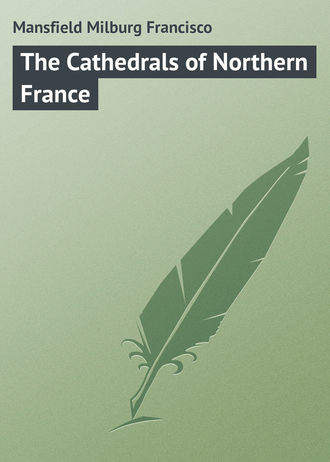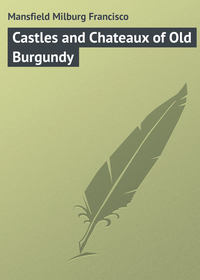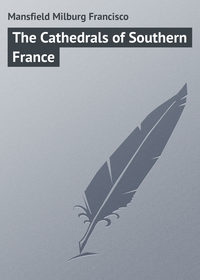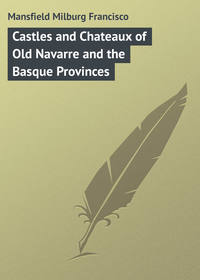 полная версия
полная версияThe Cathedrals of Northern France
The choir stalls are of excellent wooden carving, but the high altar is modern, dating only from 1874. The choir screen, of the fourteenth century, shows twenty-three reliefs in stone, once richly gilded, but now tarnished and dull.
ST. LOUIS DE VERSAILLES
Allied with the see whose jurisdiction includes the Diocese of the Department of the Seine, should be considered that of Seine and Oise, which has its bishop's throne esconced in the Cathedral of St. Louis at Versailles. To all intents and purposes the town is one of those conglomerate units which go to make up the "traveller's Paris." More can hardly be said with due regard to the magnificent edifices with which this cathedral must naturally be classed. The other attractions of this "court suburb" are so appealing to the sentimentally inclined that it is to be feared that such will have little eye for the very minor attractions of the cathedral. The Trianons, the "Grandes Eaux" and the "Petites Eaux" are all in all to the visitor to Versailles.
As a matter of fact and record, the Cathedral of St. Louis must be mentioned, if only to be dismissed in a word. Bourasée refers to it as "a thing cold, unfeeling, and without life." Truthfully, it is a remarkably ugly building of the middle eighteenth century, with no details of note and no memorials worthy of even a passing regard, except a monument to the Duc de Berry, who died in 1820. What embellishment is given to the interior, is accounted for by the exceeding ruddy glow shed by the contemporary coloured glass of the none too numerous windows.
VII
ST. JULIEN; LE MANS
Le Mans, like Chartres, sprang from an ancient Celtic hill fort, and, through successive stages, has since grown to a Roman, a mediæval, and finally a modern city. It crowns the top of a very considerable eminence, the like of which, says Professor Freeman, does not exist in England. Like Chartres, too, it has always retained the balance of power which has made it the local civil and ecclesiastical capital of its province. It is, too, more closely associated in English minds than is Chartres, forming as it did a part of the dominion of a common sovereign; also by reason of being the birthplace of Henry II., and the burial-place of Queen Berengaria, the wife of Richard Cœur-de-Lion.
Le Mans stands, without doubt, in advance of Chartres in the importance and number of its secondary churches, as well as its ecclesiastical, civil, and military establishments in general. In spite of all this, the city has never ranked as of supreme importance as a European city; nor did it ever attain the rank in Gallic times, that the events which have been woven around it would seem to augur. To-day it is a truly characteristic, large, provincial town of little or no importance to the outside world. Self-sufficient as to its own importance, and the events around which its local life circles, it gives little indication of ever becoming more of a metropolis than it now is; indeed the census figures would indicate that the department, of which it is the capital, has remained stationary as to the numbers of its population, since the Revolution.
Writers have endeavoured to carry the similarity to English interests and conditions still farther than the events of history really go to prove, and have declared that Maine and England should have united in repelling their common invader. Endeavour has also been made to trace similarity between the communistic principles of days gone by, which took form here and at Exeter across the Channel, and have even remarked the similarity of the topographical features of the surrounding landscape, wherein the country round about differs so from other parts of France, being here rolling, hilly, and wooded, as in certain parts of England; and even stretching a point to include the hedgerows, which, it must be admitted, are more in evidence in Maine than elsewhere in France. But these observations apparently prove nothing except that the majority of persons probably know very little of the real conditions which exist in the provinces of France, preferring rather that their journeyings afield should follow more the well-worn road of their compatriots.
The Cathedral of St. Julien well represents the two distinct epochs in which church architecture, as it remains to us to-day, was practised here, and shows, to well-nigh the fullest expression possible, the two principal transformations of Christian architecture.
As the Angevin style partakes so closely of northern and southern types intermixed, so the distinctive architectures of Maine, if such there be, may be said to favour the styles of both Normandy and Anjou; at least so far as the cathedral at Le Mans shows a combination of Angevin and Norman detail. The really distinctive southern influence is to be noted in the Romano-Byzantine nave, the exterior of which, so far as the western front is concerned, is far more notable in the rigidness and austerity of its lines, than by any richness of ornamentation or decoration. Nothing could be more simply plain than this portal, and the wall and gable which surmount it. A large bare window, of the variety of that at Angers, stands above the doorway, which, itself, lacks all attempt at embellishment. What decoration the façade bears is after the true Byzantine manner, of the nature of brickwork displayed and set into the wall in geometrically angular fashion. What sculpture there is, two grotesque animals on either of the buttresses which flank the façade, is of minor account. This, then, is the extent of the detail of this severe western façade, the grand portal of the usually accepted great church being entirely lacking and evidently not thought of as a desirable detail when this portion of the structure was erected. It has nothing of the prodigious art expression of the frontispieces of the grand Gothic churches of the north, or of the less poverty-stricken Byzantine decoration of its own Meridional portal, which, in so far as the style can be said to take on richness of form, shows the transition tendencies of the early twelfth century. This doorway is surmounted by a tympanum, ornamented by a figure of the Saviour surrounded by the four Evangelists, a subject which has always proved itself a highly successful and popular ecclesiastical symbol, and one which in this case, as in most others, is well made use of. All the figures have suffered considerably from the ravages of time, but retain much of their interest and charm in spite of such mutilation. A tower of Romanesque foundation, but of fifteenth and sixteenth century completion, flanks this south transept.
The ranking portion of this interesting church is its choir, larger in superficial area than the entire cathedrals of Noyon or Soissons. Both from inside and out, it is all that one's imagination could possibly invent. Its great proportions are as harmonious and graceful as the lines of a willow-tree; in fact, as to general effect, it may be set down as a thing of extraordinary grandeur, worthy to rank with Beauvais or Amiens, and yet different from either, of a quality its very own. At the commencement of the thirteenth century the canons obtained, from Philip Augustus, permission to extend their church beyond the city walls in an easterly direction, and then it was that this wonderful choir took shape. The work was undertaken in 1217 and was completed soon after the middle of the same century, and the body of St. Julien, the first apostle to Le Mans, for whom the church was named, was placed therein by Geoffroy de Loudon, then bishop, who decorated the windows of the choir with the magnificent glass with which they are still set.
From a certain distance to the eastward the cathedral at Le Mans presents a view of the choir, unique in all the world. Other greater ones there are, if mere height be concerned, and others with more perfect appendages; but none give the far-spreading effect of encircling chapels, or are possessed of high springing buttresses of more grace or beauty than are seen here. He was a rash man who ranked the flying buttresses as a sign of defective construction, indicating structural weakness, meaningless and undecorative ornament, and what not. Few have agreed with this dictum, and few ever will after they have seen Paris, Beauvais, and Le Mans.
The interior is one of great interest; the nave, even in its early forms, is none the less attractive because of its austerity. It is, as a matter of fact, far more interesting here than in its exterior, the swarthy circular pillars holding aloft arches with just a suspicion of the ogival style, with narrow, low, and disproportionately small windows in the aisles, where are also a series of strengthening pillars of black and white stone, presenting again a reminiscence of the southern manner, or at least recalling the slate and stone of Angers. In the choir, with its girdling chapels and double ambulatory, we come upon the most impressive portion of all. Slightly orientated from the east and west, it presents by itself, like Beauvais, nearly all of the attributes of a great church. The columns, arcades, and windows throughout are all of an unusual elegance and grace, the vaulting rising with much daring to a remarkable height, which must approach one hundred and ten or more feet, and the equal of certain other "popularly notable" buildings.
The rose window of the south of the transept is a remarkable example of these masterpieces of the French builder. The framing and the glass with which it is set is of the richest quality, though it dates only from the fifteenth century. The organ case is here found in the south transept, an unusual arrangement in a French church, where it is usually placed over the western doorway. The vaulting, too, is much loftier here than in the nave. The aisles of this remarkable choir have the further unusual attribute of three ranges of openings, while the clerestory, only, rises above, but with great and imposing beauty. There are a few funeral monuments of more than ordinary interest, including that of Queen Berengaria, wife of Richard, the Lion-Hearted, brought from the Abbey de l'Epau in 1821; a sarcophagus and statue in white marble of Charles of Anjou, Count of Maine, King of Jerusalem and Sicily (d. 1472), and the mausoleum of Langey du Bellay. In the north aisle are a number of fifteenth or sixteenth century tapestries. The former bishop's palace was burned by the Germans in 1871.
VIII
NOTRE DAME DE CHARTRES
Aside from their wonderful, though non-similar, cathedrals, Chartres and Le Mans, its neighbour, have much in common. Both have been possessed of a brilliant array of counts and prelates, both grew from a Celtic village to their present grand proportions through a series of vicissitudes, wars, and conquests, until to-day each is preëminent within its own sphere, and has become not only a centre of ecclesiastical affairs, but of civil life as well.
The Counts of Chartres and of Blois, in the middle ages, were a powerful race of men, and should ever be associated with profound respect in English minds by the fact that here was the birthplace of Adela, the mother of King Stephen of Blois, and of Henry, Bishop of Winchester.
As for local conditions to-day, Chartres, while having grown to the state which it now occupies through events which have made it a city of mark, remains a somnolescent, sparsely built town, with little suggestion of the progress of modernity. More frequently mentioned in the note-books of the traveller than Le Mans, it offers perhaps no greater charms. To be sure, its cathedral, by reason of its open situation and the charming quality and effect produced by its spires and its one hundred and thirty windows of coloured glass, at once places it at the very head amongst the great "show pieces" of France; but it is in connection with Le Mans, scarcely eighty miles away and so little known, that it ought really to be studied and considered; which as a matter of fact it seldom is. The city is hardly in keeping with what we are wont to associate with the environment of a great cathedral, though this of itself in no way detracts from its charms. The weekly cattle-market takes place almost before its very doors, and the battery of hotels which flank the open square present the air of catering more to the need of the husbandman than to the tourist; – not a wholly objectionable feature, either.
Beyond such evidences as an occasional sign-board announcing the fact that the hostelry possesses a garage, fosse, or what not for the necessitous requirements of the automobilist, the inns remain much as they always were, mere bourgeoise caravansaries.
The Cathedral of Notre Dame de Chartres jumps full into view immediately on leaving the railway station, though here it is to be noted that no delineation has ever been made by modern hand which shows its façade in its entirety. The roofs of the houses and shops around its base indicate no special squalor or poverty, as is the case with regard to some Continental churches, and there is a picturesque grouping of firs and poplars to the left which adds considerably to an already pleasing prospect. The whole grouping is, perhaps, none the less attractive than if the façade, with those extraordinarily beautiful non-contemporary spires, stood quite unobstructed. In fact, it is doubtful if many a monumental shrine might not lose considerably, were it taken from its environment and placed in another which might not suit its graces so well.
These really fascinating spires, famed of all writers, archæologists, and painters alike, are the clef by which the whole harmony is sounded. One cannot but echo, and reëcho, all that has been said of them, though in a quandary as to which of the two is the more beautiful: the plain, simple, symmetrical, older spire, or that wonderful work of Texier's, replacing another burned in 1506, which rises in gently sculptured and tapered ranges to a height which exceeds its companion by some twenty-five feet. No more appropriate or convincing wording could be given of it than by quoting Fergusson's estimate, which sums it up as being "the most beautifully designed spire in Europe, surpassing even Strasburg and Antwerp."
It is rather a pity that from no suitably near-by point can one obtain a full view of the effect of the western façade. One poor little house seems ever to thrust itself into the ensemble, though it is to-day apparent that certain others, which must have cut into the front still more, have been cleared away. Clearly, with all its charm and beauty of detail, it is for its great and general excellencies that the cathedral at Chartres most impresses itself upon the memory.
Visitors to-day will have no easy task in locating Lowell's "little pea-green inn," in which he indited the lines, "A Day in Chartres;" as appreciative and graceful an estimate of an inanimate thing as ever was made in verse:
"The Grecian gluts me with its perfectnessUnanswerable as Euclid, self-contained,The one thing finished in this hasty world.But ah! this other, this that never ends,Still climbing, luring fancy still to climb,As full of morals, half divined, as life,Graceful, grotesque, with ever new surpriseOf hazardous caprices, sure to please,Heavy as nightmare, airy light as fern,Imagination's very self in stone."Among the other attractions of the west façade is the Porte Royale, so called, the central doorway which was only opened for the entrance of the sovereign. It is decorated with the "signs of the zodiac" and "symbols of the months." Next in point of richness are the grandly effective north and south porches, with their triple doorways or portals, setting back some twenty feet from their jambs, which, as at Noyon, and in the smaller church at Louviers, are pierced with a transverse passage.
The north porch, with its range of three open-sided and deeply recessed doorways, has unmistakably debased tendencies, but is filled with sculptured statuary of more than ordinarily effective disposition, more remarkable for magnitude and ornateness than for finesse of skill and workmanship, or even as a detail of good taste.
The life-size statues of all three recesses are held aloft by pedestals, on pillars of twisted and of spiralled trunks, a formation reviled by Ruskin, but producing an effect much more pleasing than some galleries of effigies we have seen, where the figures appear as if hung up by the hair of their heads, or are clinging to the walls by invisible spurs at their heels, or, as is not infrequently the case, are standing or hung on nothing, as though they were graven of some bewitched magnetic stone. Here for the first time is seen, in the sculptured figures of the three great portals, the plastic forms which were to add so greatly to the Gothic architecture: male and female saints, Evangelists, and Apostles in great array, all somewhat more than life-size. Only one adverse impression is cast: that of petrifaction. The figures, almost without exception, appear as integral parts of the architectural fabric, rather than as added ornament. They are most ungainly, tall, stiff, and column-like, much more so than similar works at Reims, or at Amiens, where the sculpture has something of the vigour and warmth of life.
The south porch, erected in the reign of Henry I. by Jean Cormier, partly from donations of Matilda, queen of the Norman Conqueror, contains a series of basso relievos, – seen also in the arches of the choir, – manifestly not of good Gothic principle, and one which is the very antithesis of the northern spirit, as the name itself implies.
The earliest portion of the existing church, the crypt, is that of a timber-roofed structure burned in 1020. It was erected early in the eleventh century by Fulbert, the famous Bishop of Chartres, also remembered – possibly revered – as being the prolific letter-writer of his time.
John of Salisbury was bishop in the next century, and under him were built the lower stages of the western façade and towers. In this church Edward III. called for the help of Heaven to aid his plans, and here Henry of Navarre was crowned King of France, a change of venue from Reims, where so many previous and subsequent coronations were held.
The interior gives a deal of the thrill for which one should always be prepared. The gloom, so apparent at first, slowly brightens as the eye becomes accustomed to the finely filtered light, which penetrates through the gorgeous coloured glass, a feature which ranks with the spires as a vivid impression to be carried away. Nearly all of this glass is of equal worth and attractiveness, being, with the exception of three windows of a late date, and a few uncoloured ones, all of the gorgeous thirteenth-century variety.
The whole mass of the clerestory throughout gives the effect of windows heavily hung with tapestries through which the outside light pierces in minute rays. This comparison is made advisedly, inasmuch as, regardless of the quality and value of the glass, it is composed mainly of those minute and fragmentary particles often more rich in colour than design.
There is little doubt but that the result of the deep rich blue, claret, and orange gives a first effect of insufficient lighting which would try an artist or photographer sorely, though not a detracting element in churches which would often appear cold and unconvincing were such an attribute lacking. There are also three magnificent rose windows of great size (thirty to forty feet), containing equally good glass.
A double ambulatory surrounds the seven-chapeled choir, which is further enclosed by a magnificent sculptured stone screen begun in the sixteenth century by Texier, who designed the marvellous north spire. The Vierge du Pilier of the north choir aisle, a fifteenth-century shrine, is the subject of great local veneration. The treasury contains a relique in the form of the veil of the Virgin, supposed to have been presented by Charlemagne to Princess Irene.
Other interior details of note are an eleventh-century font; the large crypt beneath the choir; the unequal level of the pavement of nave and choir; and the maze, which still exists in the nave. This last feature is a winding circular path some forty odd feet in diameter, and, in all, perhaps a thousand feet long. As a penance in place of a pilgrimage to Jerusalem, "the journey of the maze" was performed by the penitent on his knees – taking perhaps an hour or more, according to the size and length of the path, which varied with different churches where they formerly existed. The other most notable example in France is at St. Quentin, northeast of Paris.
IX
NOTRE DAME DE REIMS
The very ancient city of Reims, now the capital of the Department of the Marne, was a large centre of population when it first fell under the sway of the Romans. During Cæsar's occupation it was known as Duroctorum, in the Præfecture of the Gauls.
A powerful metropolis and a faithful adherent of the Romans, the city early attained prominence as a centre of Christianity. St. Sixte preached the word here shortly after the first bishopric was founded, after capture by the Vandals in 406 A. D. The city was practically razed by Attila, who afterward met defeat at Chalons. During the Roman Empire it was the most important town of the Province of Belgica Secunda, later becoming known as the capital of the Remi, the name given to the people inhabiting the country round about.
In 508 A. D. the Franks under Childeric captured the city, and in 720 A. D. Charles
Martel captured it from Bishop Rigobert. Here, too, Pope Stephen had his famous interview with Pepin, and attended the crowning of Louis le Débonnaire in 816 A. D. In 744 it was made an archbishop's see, with suffragans at Amiens, Beauvais, Chalons, and Soissons. It is to-day the ecclesiastical capital of France – the Archbishop of Reims being the metropolitan prelate.
Clovis, son of Childeric, King of the Ripuarian Franks, in 496 A. D. conquered the last Roman stronghold at Soissons, and, having married a Burgundian princess, Clotilda, was induced to accept Christianity. He was accordingly baptized here by St. Remi on Christmas Day, 496 A. D.
Leo III. met Charlemagne here; a council was held in 1119 A. D. by Calixtus II. in an attempt to reconcile Henry I. and Louis le Gros; and, later, another, to excommunicate another Henry.
Succeeding years saw a continuity of archbishops, who achieved by their religious works a world-wide fame and glory. In these early days they held the temporal as well as spiritual power of the cities, and in some instances even coined their own specie.
In spite of the changes of the times and conditions of life, the ancient capital of Belgica Secunda still remains the chief city of the Departments of the Marne, Ardennes, and Aisne. Its ecclesiastical and secular monuments, headed by the grand Cathedral of Notre Dame, form an array which is well worthy of such extended consideration as the traveller or student can give. The Benedictine Abbey, the Church of St. Remi, is likewise notable in all of its dimensions and details. Its construction dates from 1162-1506, though the remains of a former tenth-century structure are made use of therein. Its chief treasure is the tomb of St. Remi, a wonderful Renaissance funeral monument of imposing proportions. Another monumental feature of more than unusual note, is the magnificent Roman arch of the former fortress of Porte Mars. This truly majestic specimen of the work of the Roman builder is supposed to have been erected by Agrippa in 25 B. C., in honour of Augustus, although another authority puts it as late as the period of Julian, 361 A. D. At any rate, it has stood the rigours of a northern clime as well as any Roman memorial extant; indeed, has seen fall all its contemporaries of the city, for at one time Reims was possessed of no less than three other gateways, bearing the pagan nomenclature of Ceres, Mars, and Venus.
The various other memorials of the city are on a no less grand scale, but the average person will hardly have eyes and ears for more than a contemplation of the wealth of splendour to be seen in its overpowering cathedral. Of the glorious group of monumental churches of northern France, the Cathedral of Notre Dame de Reims, if not admittedly the most beautiful and memorable Gothic edifice in all France, needs but little qualifying comment. It has a preëminence which has been generally conceded, and even elaborately endorsed, by most observers qualified to pass opinion hereon. Contemplation of the wealth of detail, and of the disposition of its wonderful west front, no less than of its general excellencies, can but compel the decision that in its exterior, at least, the Cathedral of Reims is the peer of any existing Gothic fabric. Though less huge than Strasburg or Cologne, and lacking the doubled tier of flying buttresses of the latter, it is altogether the most splendid and well-proportioned Gothic mass extant. The diminishing or pyramidal effect of the towers and gable of this west façade is an exemplification of the true symmetry of Gothic form. Lofty, and not closely hemmed in by surrounding structures, it looms, from any adjacent view-point, fully two-thirds of its decorated splendour above the general skyline round about. Aside from modern adulation we have the praise of an early historian, who delivers himself thus:









